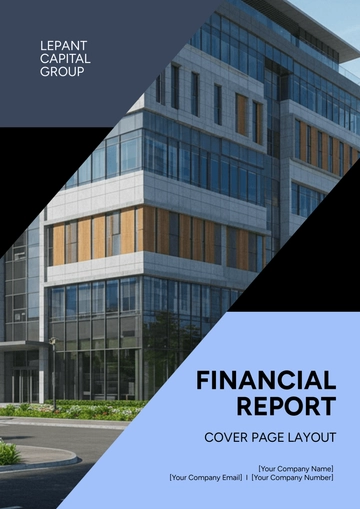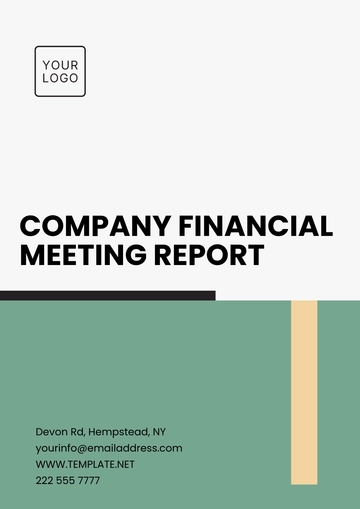Free Hotel Financial Report

I. Executive Summary
A. Introduction
This financial report provides an in-depth analysis of the financial performance of [Your Company Name] for the fiscal year ending December 31, 2050. The report is designed to offer a comprehensive view of the company's financial health, covering detailed financial statements, key performance indicators, revenue analysis, expense breakdown, and future financial projections. The aim is to provide stakeholders, including investors, management, and other interested parties, with clear insights into the company’s performance and strategic direction.
B. Key Highlights
Total Revenue: $25,000,000, an increase of 10% from the previous year, demonstrating robust growth driven by enhanced marketing efforts and customer satisfaction initiatives.
Net Profit: $5,000,000, reflecting a 15% increase, attributed to effective cost management and higher occupancy rates.
Occupancy Rate: 85%, compared to 80% in the previous year, indicating improved room utilization and successful demand management strategies.
Average Daily Rate (ADR): $150, up from $140, showing an increase in the willingness of customers to pay for quality services and amenities.
Revenue Per Available Room (RevPAR): $127.50, an increase from $112, highlighting improved overall performance and revenue generation capabilities.
C. Strategic Objectives
Revenue Growth: Target a 12% increase in total revenue for the next fiscal year through strategic market expansions and enhanced service offerings.
Cost Management: Implement measures to reduce operating expenses by 5% by optimizing energy use, streamlining supply chains, and improving operational efficiencies.
Customer Satisfaction: Achieve a guest satisfaction score of 90% by enhancing customer service training, upgrading amenities, and personalizing guest experiences.
II. Financial Statements
A. Income Statement
The income statement provides a summary of revenues, costs, and expenses during the fiscal year. It reflects the company's ability to generate profit by managing costs and maximizing revenue.
Item | Amount ($) |
|---|---|
Total Revenue | 25,000,000 |
Cost of Goods Sold | 8,000,000 |
Gross Profit | 17,000,000 |
Operating Expenses | 10,000,000 |
Operating Profit | 7,000,000 |
Interest Expense | 500,000 |
Net Profit Before Tax | 6,500,000 |
Tax Expense | 1,500,000 |
Net Profit | 5,000,000 |
B. Balance Sheet
The balance sheet provides a snapshot of the company’s financial position at the end of the fiscal year, detailing assets, liabilities, and equity.
Assets | Amount ($) |
|---|---|
Current Assets | |
Cash and Cash Equivalents | 3,000,000 |
Accounts Receivable | 1,500,000 |
Inventory | 500,000 |
Prepaid Expenses | 200,000 |
Total Current Assets | 5,200,000 |
Non-Current Assets | |
Property, Plant, and Equipment | 20,000,000 |
Intangible Assets | 2,000,000 |
Total Non-Current Assets | 22,000,000 |
Total Assets | 27,200,000 |
Liabilities and Equity | Amount ($) |
|---|---|
Current Liabilities | |
Accounts Payable | 1,000,000 |
Short-Term Debt | 2,000,000 |
Accrued Liabilities | 300,000 |
Total Current Liabilities | 3,300,000 |
Non-Current Liabilities | |
Long-Term Debt | 10,000,000 |
Total Non-Current Liabilities | 10,000,000 |
Total Liabilities | 13,300,000 |
Equity | |
Common Stock | 2,000,000 |
Retained Earnings | 11,900,000 |
Total Equity | 13,900,000 |
Total Liabilities and Equity | 27,200,000 |
C. Cash Flow Statement
The cash flow statement provides an overview of the company’s cash inflows and outflows from operating, investing, and financing activities, highlighting the company’s liquidity and cash management efficiency.
Item | Amount ($) |
|---|---|
Cash Flow from Operating Activities | |
Net Profit | 5,000,000 |
Depreciation and Amortization | 1,500,000 |
Changes in Working Capital | 300,000 |
Net Cash from Operating Activities | 6,800,000 |
Cash Flow from Investing Activities | |
Purchase of PPE | (2,500,000) |
Sale of Equipment | 100,000 |
Net Cash from Investing Activities | (2,400,000) |
Cash Flow from Financing Activities | |
Proceeds from Long-Term Debt | 3,000,000 |
Repayment of Debt | (1,500,000) |
Dividends Paid | (1,000,000) |
Net Cash from Financing Activities | 500,000 |
Net Increase in Cash and Cash Equivalents | 4,900,000 |
Cash and Cash Equivalents at Beginning of Year | 2,000,000 |
Cash and Cash Equivalents at End of Year | 6,900,000 |
III. Revenue Analysis
A. Revenue by Source
Revenue analysis by source allows for a clear understanding of the main revenue streams and their respective contributions to the total revenue. This segmentation helps in identifying areas of strength and potential growth.
Revenue Source | Amount ($) | Percentage (%) |
|---|---|---|
Room Revenue | 18,000,000 | 72% |
Food and Beverage | 5,000,000 | 20% |
Other Services | 2,000,000 | 8% |
Total Revenue | 25,000,000 | 100% |
Analysis: Room revenue remains the primary source of income, contributing 72% to the total revenue. This dominance underscores the importance of maintaining high occupancy rates and competitive pricing. Food and beverage sales have shown a steady increase, constituting 20% of total revenue. This growth can be attributed to enhanced dining options and promotional events. Other services, including spa and conference facilities, account for 8%, highlighting the potential for further diversification of revenue streams.
B. Revenue by Season
Revenue by season analysis provides insights into the seasonal variations in revenue generation, helping to understand demand patterns and optimize pricing and marketing strategies accordingly.
Season | Revenue ($) | Percentage (%) |
|---|---|---|
Q1 (Winter) | 5,000,000 | 20% |
Q2 (Spring) | 6,000,000 | 24% |
Q3 (Summer) | 8,000,000 | 32% |
Q4 (Fall) | 6,000,000 | 24% |
Total Revenue | 25,000,000 | 100% |
Analysis: The summer season (Q3) is the most lucrative, contributing 32% to annual revenue due to high tourist influx and vacationers. This trend reflects the hotel's strategic focus on maximizing occupancy and rates during peak periods. Winter (Q1) and fall (Q4) each contribute 20% and 24%, respectively, while spring (Q2) also brings a substantial 24% of annual revenue. The relatively balanced distribution across seasons indicates a stable revenue flow, reducing the risks associated with seasonal fluctuations.
IV. Expense Breakdown
A. Operating Expenses
Operating expenses are crucial for maintaining the quality of services and overall operational efficiency. A detailed breakdown helps identify key areas of expenditure and potential cost-saving opportunities.
Expense Category | Amount ($) | Percentage (%) |
|---|---|---|
Salaries and Wages | 4,000,000 | 40% |
Utilities | 1,200,000 | 12% |
Maintenance | 800,000 | 8% |
Marketing and Advertising | 500,000 | 5% |
Supplies and Inventory | 1,000,000 | 10% |
Other Operating Expenses | 2,500,000 | 25% |
Total Operating Expenses | 10,000,000 | 100% |
Analysis: Salaries and wages are the largest expense category, accounting for 40% of total operating expenses, reflecting the labor-intensive nature of the hotel industry. Effective human resource management is essential to control these costs while ensuring high service standards. Utilities and maintenance costs together constitute 20%, indicating significant expenditure on operational efficiency and infrastructure upkeep. Marketing, supplies, and other operating expenses account for the remaining 40%, highlighting the importance of strategic investments in brand building and operational needs.
B. Cost of Goods Sold
The cost of goods sold (COGS) includes all direct costs associated with producing the goods and services offered by the hotel. This section provides a detailed breakdown to understand the primary cost drivers.
Item | Amount ($) |
|---|---|
Food and Beverage Supplies | 3,000,000 |
Housekeeping Supplies | 2,000,000 |
Guest Amenities | 1,000,000 |
Total COGS | 6,000,000 |
Analysis: Food and beverage supplies constitute the majority of COGS, reflecting the importance of maintaining quality and variety in dining options. Housekeeping supplies and guest amenities are also significant, emphasizing the need for continuous investment in guest comfort and satisfaction.
V. Key Performance Indicators (KPIs)
A. Occupancy Rate
Occupancy rate is a crucial KPI that measures the percentage of available rooms that are occupied during a specific period.
Month | Occupancy Rate (%) |
|---|---|
January | 70 |
February | 72 |
March | 75 |
April | 80 |
May | 85 |
June | 90 |
July | 95 |
August | 92 |
September | 88 |
October | 82 |
November | 78 |
December | 75 |
Annual Average | 85 |
Analysis: The occupancy rate shows a positive trend, peaking in July at 95% due to the high tourist season. The average annual occupancy rate of 85% indicates strong demand and effective marketing strategies. Efforts to boost occupancy during off-peak months through promotions and partnerships have yielded positive results.
B. Average Daily Rate (ADR) and Revenue Per Available Room (RevPAR)
ADR and RevPAR are critical metrics for evaluating the financial performance of the hotel. ADR indicates the average revenue earned per occupied room, while RevPAR measures revenue per available room, combining occupancy rate and ADR.
Month | ADR ($) | RevPAR ($) |
|---|---|---|
January | 140 | 98 |
February | 142 | 102.24 |
March | 145 | 108.75 |
April | 148 | 118.4 |
May | 150 | 127.5 |
June | 155 | 139.5 |
July | 160 | 152 |
August | 158 | 145.36 |
September | 154 | 135.52 |
October | 150 | 127.5 |
November | 148 | 115.44 |
December | 145 | 108.75 |
Annual Average | 150 | 127.5 |
Analysis: The ADR and RevPAR demonstrate a steady increase during peak months, particularly in summer. July records the highest ADR at $160 and RevPAR at $152, indicating optimal pricing and high occupancy. The annual average ADR of $150 and RevPAR of $127.50 reflect a balanced pricing strategy that maximizes revenue while maintaining competitive rates.
VI. Future Financial Projections
A. Revenue Projections
Future revenue projections are essential for strategic planning and setting realistic financial targets. These projections are based on historical data, market trends, and planned initiatives.
Year | Projected Revenue ($) | Growth Rate (%) |
|---|---|---|
2051 | 28,000,000 | 12 |
2052 | 31,360,000 | 12 |
2053 | 35,123,200 | 12 |
2054 | 39,337,984 | 12 |
2055 | 44,068,543 | 12 |
Analysis: With an annual growth rate target of 12%, projected revenues show a substantial increase, reaching $44,068,543 by 2055. This growth is anticipated through enhanced marketing strategies, improved customer experiences, and expansion of service offerings. The consistent growth rate reflects confidence in the company’s strategic direction and market potential.
B. Expense Projections
Accurate expense projections are crucial for maintaining profitability while supporting revenue growth. These projections take into account inflation, planned investments, and cost-saving initiatives.
Year | Projected Expenses ($) | Growth Rate (%) |
|---|---|---|
2051 | 10,500,000 | 5 |
2052 | 11,025,000 | 5 |
2053 | 11,576,250 | 5 |
2054 | 12,155,063 | 5 |
2055 | 12,762,816 | 5 |
Analysis: Operating expenses are projected to increase by 5% annually, reaching $12,762,816 by 2055. This controlled increase aligns with cost management strategies to maintain profitability while supporting revenue growth. Continuous monitoring and optimization of expenses will be critical to achieving these targets.
VII. SWOT Analysis
A. Strengths
Strong Brand Reputation: [Your Company Name] is well-known for its exceptional customer service and luxury accommodations, which contribute to high customer loyalty and repeat business.
Prime Locations: The strategic positioning of hotels in high-demand tourist areas ensures steady occupancy and premium pricing capabilities.
Diverse Revenue Streams: Multiple income sources, including rooms, food and beverage, and other services, reduce dependency on a single revenue stream and enhance financial stability.
B. Weaknesses
High Operating Costs: Significant expenditure on wages, utilities, and maintenance impacts profit margins, necessitating continuous cost optimization efforts.
Seasonal Dependence: Revenue is heavily influenced by peak tourist seasons, leading to fluctuations in cash flow and profitability.
Aging Infrastructure: Some properties require significant upgrades and renovations to maintain competitive standards and guest satisfaction.
C. Opportunities
Market Expansion: There is potential to enter new markets and regions, leveraging the brand's reputation and operational expertise to capture a broader customer base.
Technological Integration: Implementing advanced technology solutions for better customer experience, operational efficiency, and data analytics can drive growth and competitiveness.
Partnerships: Collaborations with travel agencies, online booking platforms, and other hospitality service providers can enhance visibility and increase bookings.
D. Threats
Economic Downturns: Economic instability and downturns can negatively impact travel and tourism, reducing demand for hotel services.
Competition: Increasing competition from new hotel chains and alternative lodging options like Airbnb poses a threat to market share and pricing power.
Regulatory Changes: Changes in laws and regulations affecting the hospitality industry can lead to increased compliance costs and operational challenges.
VIII. Strategic Recommendations
A. Enhance Customer Experience
Invest in Technology: Upgrade booking systems and customer service interfaces to provide a seamless and personalized experience for guests.
Loyalty Programs: Develop and promote loyalty programs to retain repeat customers and increase lifetime value. These programs can include exclusive discounts, rewards, and personalized offers.
Staff Training: Implement continuous training programs for staff to ensure high-quality service, enhance guest interactions, and improve overall satisfaction.
B. Cost Management
Energy Efficiency: Implement energy-saving measures, such as LED lighting, energy-efficient appliances, and smart thermostats, to reduce utility costs and promote sustainability.
Supply Chain Optimization: Negotiate better deals with suppliers, streamline procurement processes, and adopt just-in-time inventory management to lower costs and improve efficiency.
Operational Audits: Conduct regular audits to identify and eliminate inefficiencies in operations, ensuring optimal resource utilization and cost control.
C. Marketing and Expansion
Digital Marketing: Increase online presence through targeted digital marketing campaigns, including social media, search engine optimization (SEO), and content marketing, to attract new customers and engage existing ones.
Geographical Expansion: Explore opportunities in emerging markets, leveraging the brand's strength and market knowledge to capture new customer segments.
Strategic Partnerships: Form alliances with travel agencies, tour operators, and local businesses to boost bookings and enhance the overall guest experience through bundled offers and cross-promotions.
IX. Conclusion
The financial performance of [Your Company Name] in 2050 showcases a strong year with significant revenue and profit growth. The company has successfully navigated market challenges and leveraged its strengths to achieve impressive results. Moving forward, the focus will be on sustaining this growth through strategic investments in technology, expanding market reach, and optimizing operational efficiency. The recommendations outlined aim to position [Your Company Name] as a leading player in the hospitality industry, ensuring long-term success and profitability.
This comprehensive financial report provides a detailed overview of [Your Company Name]'s financial health and strategic direction. It serves as a valuable resource for stakeholders, offering insights into the company's past performance and future potential. By implementing the strategic recommendations and maintaining a focus on customer satisfaction, cost management, and market expansion, [Your Company Name] is well-positioned to achieve its financial objectives and continue its growth trajectory.
- 100% Customizable, free editor
- Access 1 Million+ Templates, photo’s & graphics
- Download or share as a template
- Click and replace photos, graphics, text, backgrounds
- Resize, crop, AI write & more
- Access advanced editor
Gain valuable insights into your hotel's financial performance with the Hotel Financial Report Template from Template.net. This customizable and editable document allows you to analyze key financial metrics, trends, and projections. Crafted for ease in our AI Editor Tool, generate comprehensive reports to inform strategic decisions and drive profitability.
You may also like
- Sales Report
- Daily Report
- Project Report
- Business Report
- Weekly Report
- Incident Report
- Annual Report
- Report Layout
- Report Design
- Progress Report
- Marketing Report
- Company Report
- Monthly Report
- Audit Report
- Status Report
- School Report
- Reports Hr
- Management Report
- Project Status Report
- Handover Report
- Health And Safety Report
- Restaurant Report
- Construction Report
- Research Report
- Evaluation Report
- Investigation Report
- Employee Report
- Advertising Report
- Weekly Status Report
- Project Management Report
- Finance Report
- Service Report
- Technical Report
- Meeting Report
- Quarterly Report
- Inspection Report
- Medical Report
- Test Report
- Summary Report
- Inventory Report
- Valuation Report
- Operations Report
- Payroll Report
- Training Report
- Job Report
- Case Report
- Performance Report
- Board Report
- Internal Audit Report
- Student Report
- Monthly Management Report
- Small Business Report
- Accident Report
- Call Center Report
- Activity Report
- IT and Software Report
- Internship Report
- Visit Report
- Product Report
- Book Report
- Property Report
- Recruitment Report
- University Report
- Event Report
- SEO Report
- Conference Report
- Narrative Report
- Nursing Home Report
- Preschool Report
- Call Report
- Customer Report
- Employee Incident Report
- Accomplishment Report
- Social Media Report
- Work From Home Report
- Security Report
- Damage Report
- Quality Report
- Internal Report
- Nurse Report
- Real Estate Report
- Hotel Report
- Equipment Report
- Credit Report
- Field Report
- Non Profit Report
- Maintenance Report
- News Report
- Survey Report
- Executive Report
- Law Firm Report
- Advertising Agency Report
- Interior Design Report
- Travel Agency Report
- Stock Report
- Salon Report
- Bug Report
- Workplace Report
- Action Report
- Investor Report
- Cleaning Services Report
- Consulting Report
- Freelancer Report
- Site Visit Report
- Trip Report
- Classroom Observation Report
- Vehicle Report
- Final Report
- Software Report





























